Related Research Articles
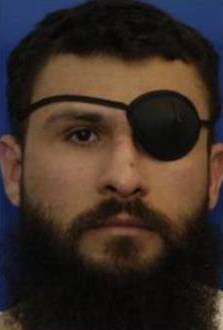
Abu Zubaydah is a Palestinian citizen born in Saudi Arabia currently held by the U.S. in the Guantanamo Bay detention camp in Cuba. He is held under the authority of Authorization for Use of Military Force Against Terrorists (AUMF).

In telecommunications, a transponder is a device that, upon receiving a signal, emits a different signal in response. The term is a blend of transmitter and responder.

The American Psychological Association (APA) is the main professional organization of psychologists in the United States, and the largest psychological association in the world. It has over 157,000 members, including scientists, educators, clinicians, consultants, and students. It has 54 divisions, which function as interest groups for different subspecialties of psychology or topical areas. The APA has an annual budget of around $125 million.
Miranda v. Arizona, 384 U.S. 436 (1966), was a landmark decision of the U.S. Supreme Court in which the Court ruled that law enforcement in the United States must warn a person of their constitutional rights before interrogating them, or else the person's statements cannot be used as evidence at their trial. Specifically, the Court held that under the Fifth Amendment to the U.S. Constitution, the government cannot use a person's statements made in response to an interrogation while in police custody as evidence at the person's criminal trial unless they can show that the person was informed of the right to consult with a lawyer before and during questioning, and of the right against self-incrimination before police questioning, and that the defendant not only understood these rights but also voluntarily waived them before answering questions.

Khalid Sheikh Mohammed, often known by his initials KSM, is a terrorist, mechanical engineer and the former Head of Propaganda for al-Qaeda. He is currently held by the United States at the Guantanamo Bay detention camp under terrorism-related charges. He was named as "the principal architect of the 9/11 attacks" in the 2004 9/11 Commission Report.

Interrogation is interviewing as commonly employed by law enforcement officers, military personnel, intelligence agencies, organized crime syndicates, and terrorist organizations with the goal of eliciting useful information, particularly information related to suspected crime. Interrogation may involve a diverse array of techniques, ranging from developing a congenial rapport with the subject to torture.
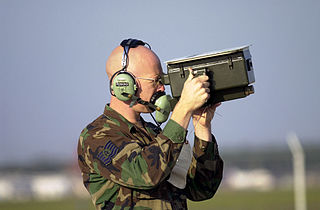
Identification, friend or foe (IFF) is a combat identification system designed for command and control. It uses a transponder that listens for an interrogation signal and then sends a response that identifies the broadcaster. IFF systems usually use radar frequencies, but other electromagnetic frequencies, radio or infrared, may be used. It enables military and civilian air traffic control interrogation systems to identify aircraft, vehicles or forces as friendly, as opposed to neutral or hostile, and to determine their bearing and range from the interrogator. IFF is used by both military and civilian aircraft. IFF was first developed during World War II, with the arrival of radar, and several friendly fire incidents.
Good cop, bad cop, also informally called the Mutt and Jeff technique, is a psychological tactic used in interrogation and negotiation, in which a team of two people take opposing approaches to the subject. One interrogator adopts a hostile or accusatory demeanor, emphasizing threats of punishment, while the other adopts a more sympathetic demeanor, emphasizing reward, in order to convince the subject to cooperate. It is an instance of the Reid technique.

Waterboarding is a form of torture in which water is poured over a cloth covering the face and breathing passages of an immobilized captive, causing the person to experience the sensation of drowning. In the most common method of waterboarding, the captive's face is covered with cloth or some other thin material and immobilized on their back at an incline of 10 to 20 degrees. Torturers pour water onto the face over the breathing passages, causing an almost immediate gag reflex and creating a drowning sensation for the captive. Normally, water is poured intermittently to prevent death; however, if the water is poured uninterruptedly it will lead to death by asphyxia. Waterboarding can cause extreme pain, damage to lungs, brain damage from oxygen deprivation, other physical injuries including broken bones due to struggling against restraints, and lasting psychological damage. Adverse physical effects can last for months, and psychological effects for years. The term "water board torture" appeared in press reports as early as 1976.

Mohammed Mani Ahmad al-Qahtani is a Saudi citizen who was detained as an al-Qaeda operative for 20 years in the United States's Guantanamo Bay detention camps in Cuba. Qahtani allegedly tried to enter the United States to take part in the September 11 attacks as the 20th hijacker and was due to be onboard United Airlines Flight 93 along with the four other hijackers. He was refused entry due to suspicions that he was trying to illegally immigrate. He was later captured in Afghanistan in the Battle of Tora Bora in December 2001.

Manadel al-Jamadi was an Iraqi national who was killed in United States custody during a CIA interrogation at Abu Ghraib prison on November 4, 2003. His name became known in 2004 when the Abu Ghraib scandal made headlines; his corpse packed in ice was the background for widely reprinted photographs of grinning U.S. Army specialists Sabrina Harman and Charles Graner each offering a "thumbs-up" gesture. Al-Jamadi had been a suspect in a bomb attack that killed 34 people, including one US soldier, and left more than 200 wounded in a Baghdad Red Cross facility.
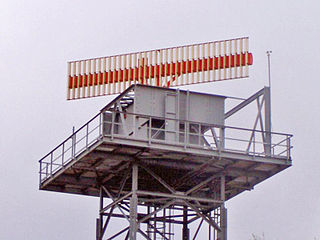
Secondary surveillance radar (SSR) is a radar system used in air traffic control (ATC), that unlike primary radar systems that measure the bearing and distance of targets using the detected reflections of radio signals, relies on targets equipped with a radar transponder, that reply to each interrogation signal by transmitting encoded data such as an identity code, the aircraft's altitude and further information depending on its chosen mode. SSR is based on the military identification friend or foe (IFF) technology originally developed during World War II; therefore, the two systems are still compatible. Monopulse secondary surveillance radar (MSSR), Mode S, TCAS and ADS-B are similar modern methods of secondary surveillance.
Davis v. Washington, 547 U.S. 813 (2006), was a case decided by the Supreme Court of the United States and written by Justice Antonin Scalia that established the test used to determine whether a hearsay statement is "testimonial" for Confrontation Clause purposes. Two years prior to its publication, in Crawford v. Washington, the Supreme Court held that the Confrontation Clause bars “admission of testimonial statements of a witness who did not appear at trial unless he was unavailable to testify, and the defendant had had a prior opportunity for cross-examination.” The Supreme Court declined to define "testimonial" in Crawford which left lower courts without any guidance. However, in Davis v. Washington, along with Hammon v. Indiana which was consolidated with Davis, the Court clarified the meaning of "testimonial" and articulated a new standard.
"Enhanced interrogation techniques" or "enhanced interrogation" was a program of systematic torture of detainees by the Central Intelligence Agency (CIA), the Defense Intelligence Agency (DIA) and various components of the U.S. Armed Forces at remote sites around the world—including Bagram, Guantanamo Bay, Abu Ghraib, and Bucharest—authorized by officials of the George W. Bush administration. Methods used included beating, binding in contorted stress positions, hooding, subjection to deafening noise, sleep disruption, sleep deprivation to the point of hallucination, deprivation of food, drink, and medical care for wounds, as well as waterboarding, walling, sexual humiliation, rape, sexual assault, subjection to extreme heat or extreme cold, and confinement in small coffin-like boxes. A Guantanamo inmate's drawings of some of these tortures, to which he himself was subjected, were published in The New York Times. Some of these techniques fall under the category known as "white room torture". Several detainees endured medically unnecessary "rectal rehydration", "rectal fluid resuscitation", and "rectal feeding". In addition to brutalizing detainees, there were threats to their families such as threats to harm children, and threats to sexually abuse or to cut the throat of detainees' mothers.
The CIA interrogation videotapes destruction occurred on November 9, 2005. The videotapes were made by the United States Central Intelligence Agency (CIA) during interrogations of Al-Qaeda suspects Abu Zubaydah and Abd al-Rahim al-Nashiri in 2002 at a CIA black site prison in Thailand. Ninety tapes were made of Zubaydah and two of al-Nashiri. Twelve tapes depict interrogations using "enhanced interrogation techniques", a euphemism for torture. The tapes and their destruction became public knowledge in December 2007. A criminal investigation by a Department of Justice special prosecutor, John Durham, decided in 2010 to not file any criminal charges related to destroying the videotapes.
Torturing Democracy is a 2008 documentary film produced by Washington Media Associates. The film details the use of torture by the Bush administration in the "War on Terror."
James Elmer Mitchell is an American psychologist and former member of the United States Air Force. From 2002, after his retirement from the military, to 2009, his company Mitchell Jessen and Associates received $81 million on contract from the CIA to carry out the torture of detainees, referred to as "enhanced interrogation techniques" that resulted in little credible information.
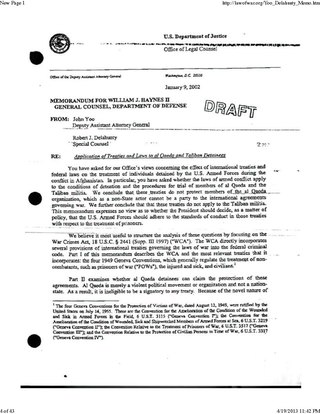
A set of legal memoranda known as the "Torture Memos" were drafted by John Yoo as Deputy Assistant Attorney General of the United States and signed in August 2002 by Assistant Attorney General Jay S. Bybee, head of the Office of Legal Counsel of the United States Department of Justice. They advised the Central Intelligence Agency, the United States Department of Defense, and the President on the use of enhanced interrogation techniques—mental and physical torment and coercion such as prolonged sleep deprivation, binding in stress positions, and waterboarding—and stated that such acts, widely regarded as torture, might be legally permissible under an expansive interpretation of presidential authority during the "War on Terror".

John Bruce Jessen is an American psychologist who, with James Elmer Mitchell, created the so-called "enhanced interrogation techniques" that were used in the interrogation and torture of CIA detainees and outlined in the United States Senate Select Committee on Intelligence's report on CIA torture. In that report, he was mentioned under the pseudonym "Hammond Dunbar." His company, Mitchell Jessen and Associates, earned US$81 million for its work.
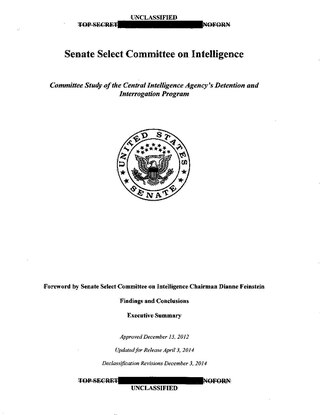
The Committee Study of the Central Intelligence Agency's Detention and Interrogation Program is a report compiled by the bipartisan United States Senate Select Committee on Intelligence (SSCI) about the Central Intelligence Agency (CIA)'s Detention and Interrogation Program and its use of torture during interrogation in U.S. government communiqués on detainees in CIA custody. The report covers CIA activities before, during, and after the "War on Terror". The initial report was approved on December 13, 2012, by a vote of 9–6, with seven Democrats, one Independent, and one Republican voting in favor of the report and six Republicans voting in opposition.
References
 This article incorporates public domain material from Federal Standard 1037C. General Services Administration. Archived from the original on 2022-01-22.
This article incorporates public domain material from Federal Standard 1037C. General Services Administration. Archived from the original on 2022-01-22.